Improving vocabulary for young learenrs through storytelling in efl classroom
Abstract: Building vocabulary plays an essential role in English learning since it could
assist learners greatly with their learning process. Particularly, a rich vocabulary
possibly leads to the confidence and success in using the language. However, enhancing
learners’ lexical resource is a challenging task for teachers due to the tedium of the
traditional teaching methods. This study, therefore, emphasizes on using storytelling to
develop vocabulary for young learners in English as a Foreign Language (EFL)
classroom. The paper focuses on four main issues. First, it discusses the definition of
storytelling and different types of stories to tell in EFL classroom. Second, it introduces
the characteristics of EFL young learners. Third, researcher analyzes the benefits of
storytelling and strategies to use storytelling in EFL classroom. Fourth, the paper
reviews the considerations when using storytelling in EFL classroom. Findings of this
study based on the review of the literature would be benefit to improve EFL young
learners’ vocabulary.
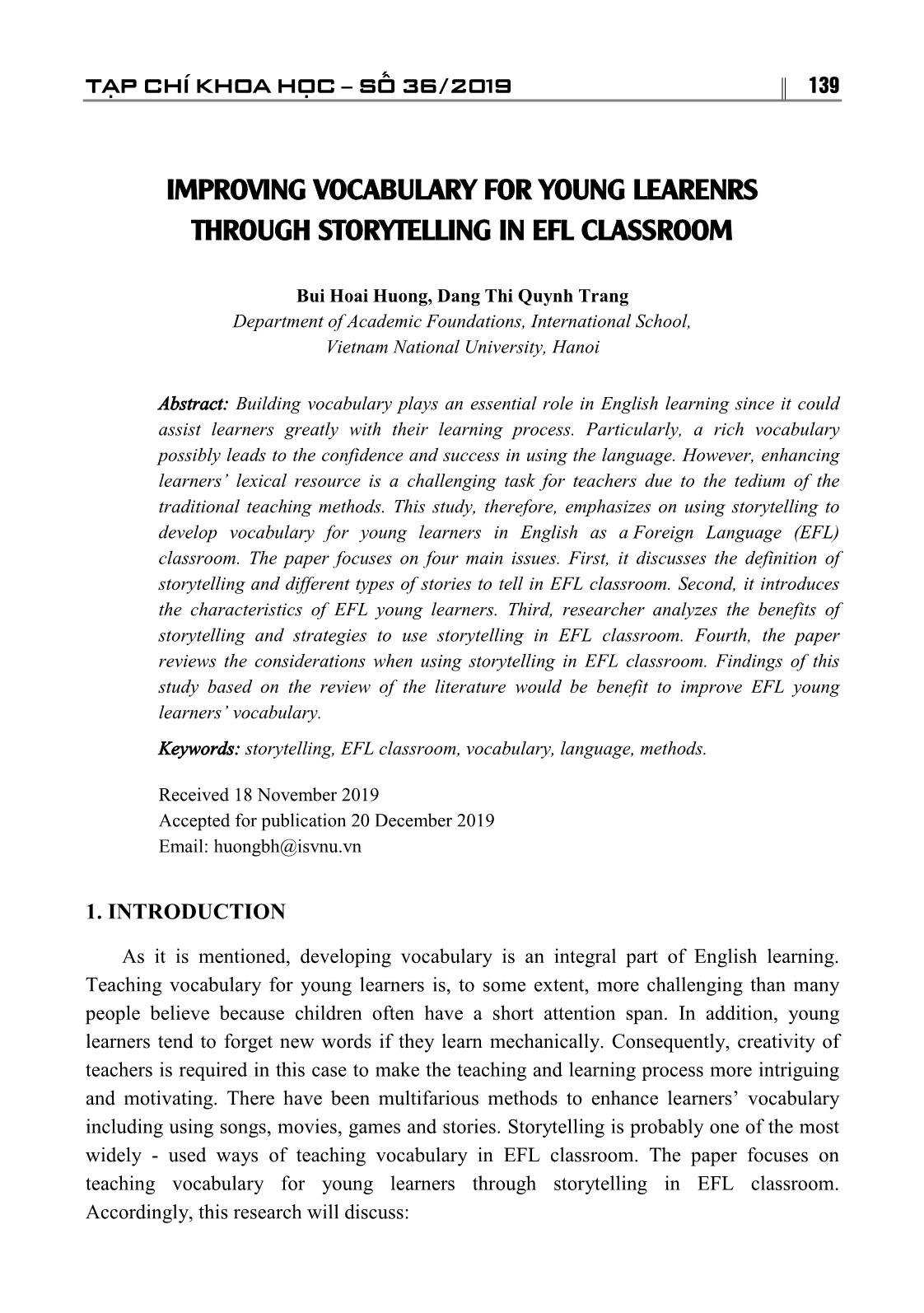
Trang 1
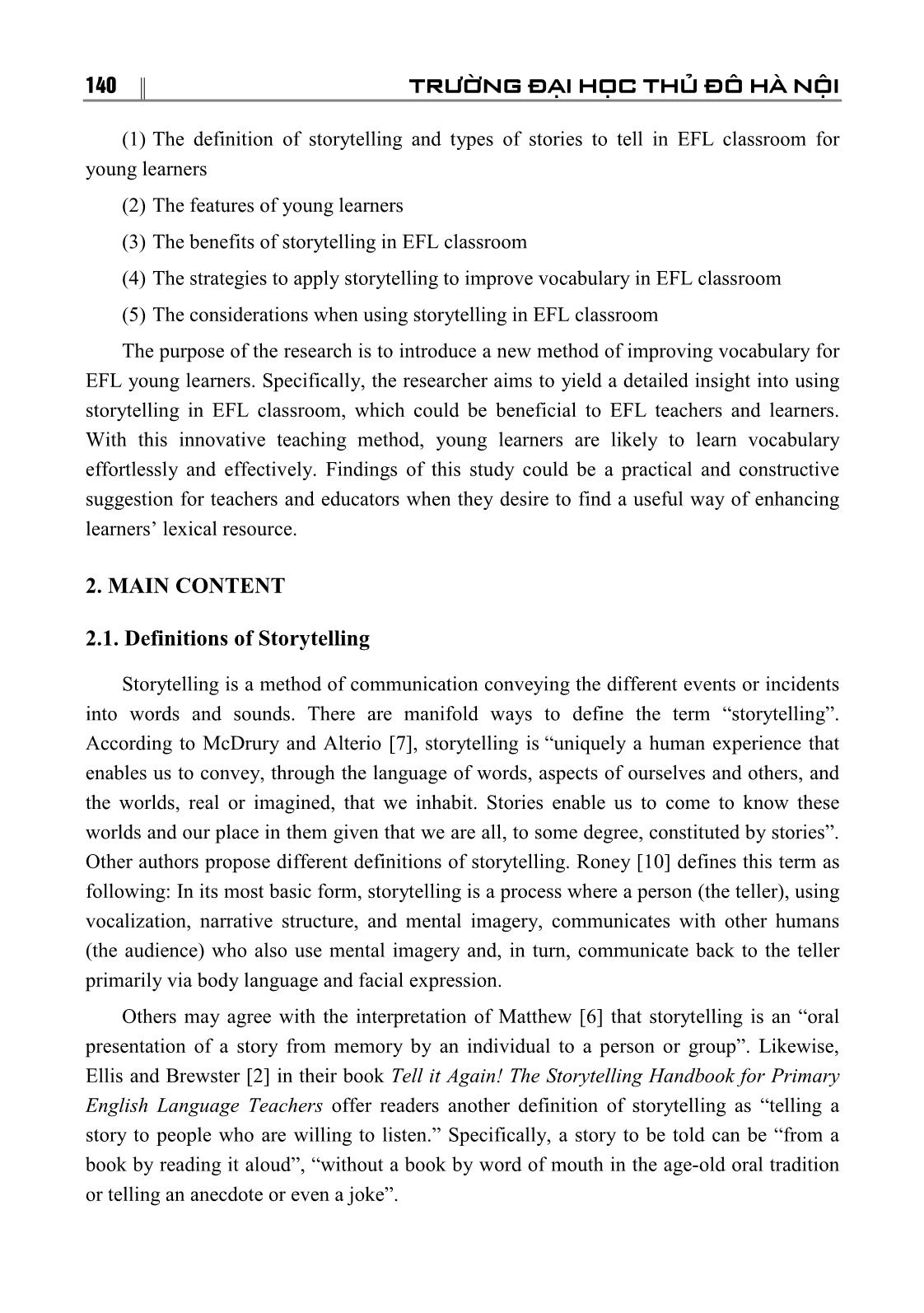
Trang 2
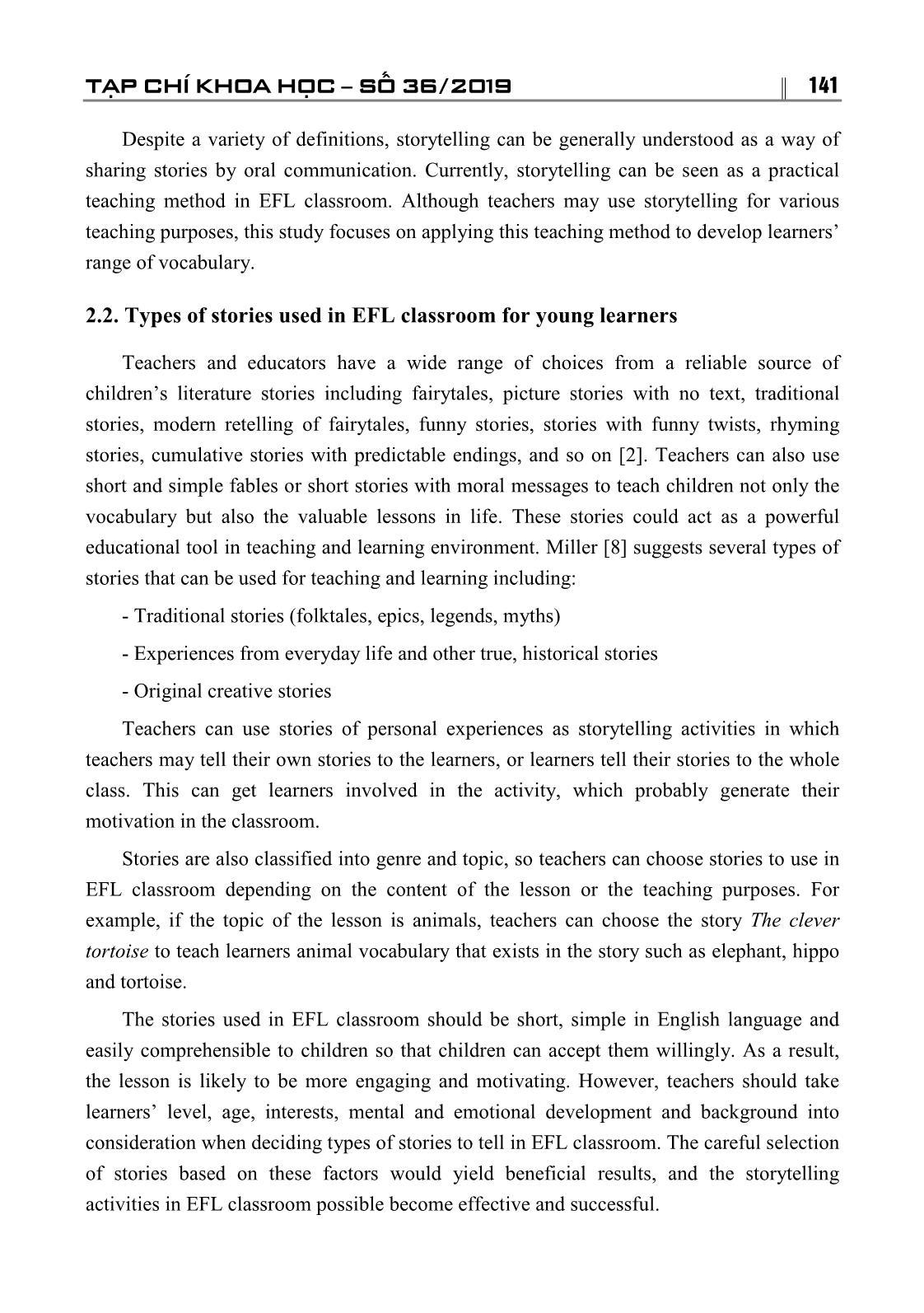
Trang 3
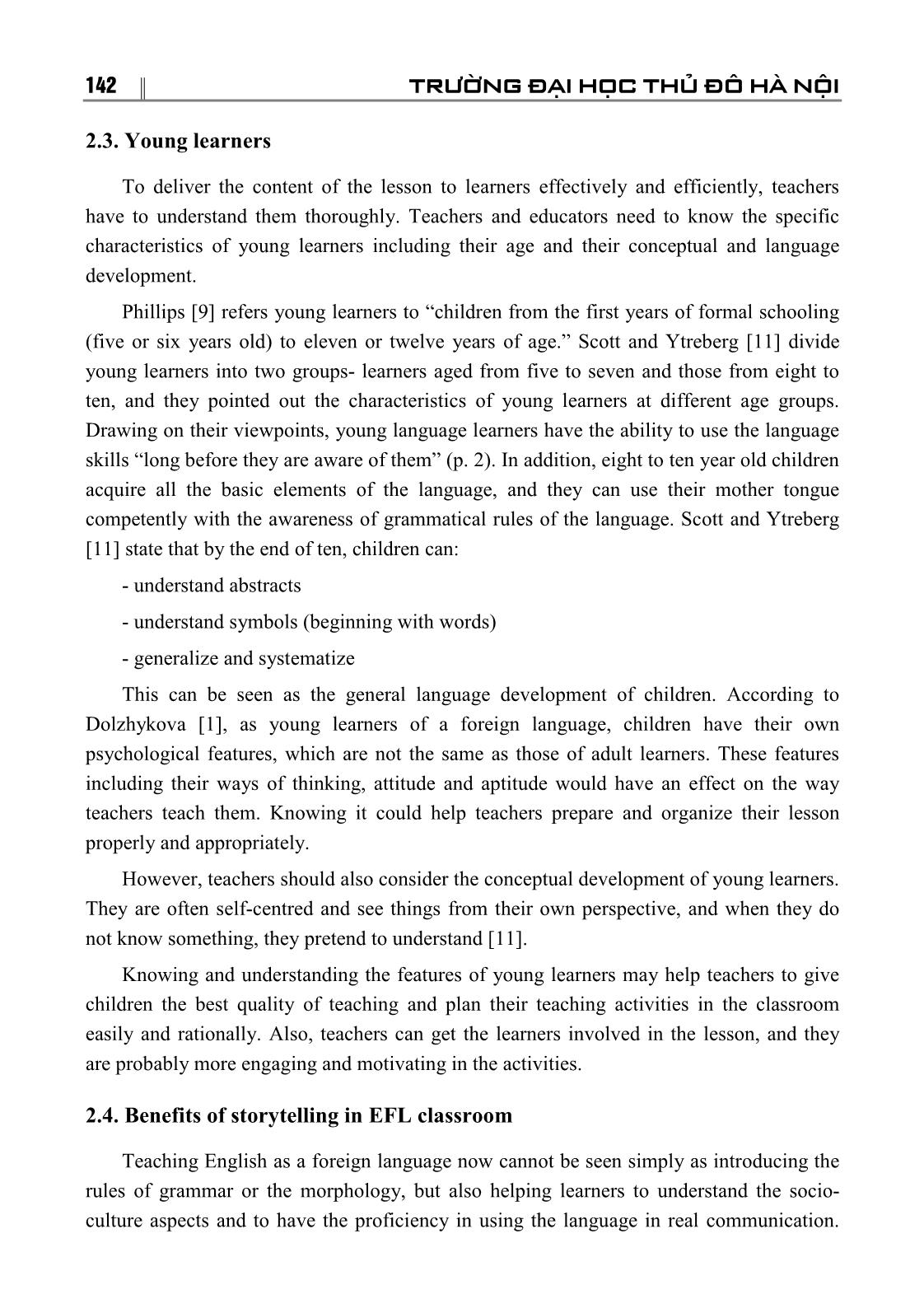
Trang 4
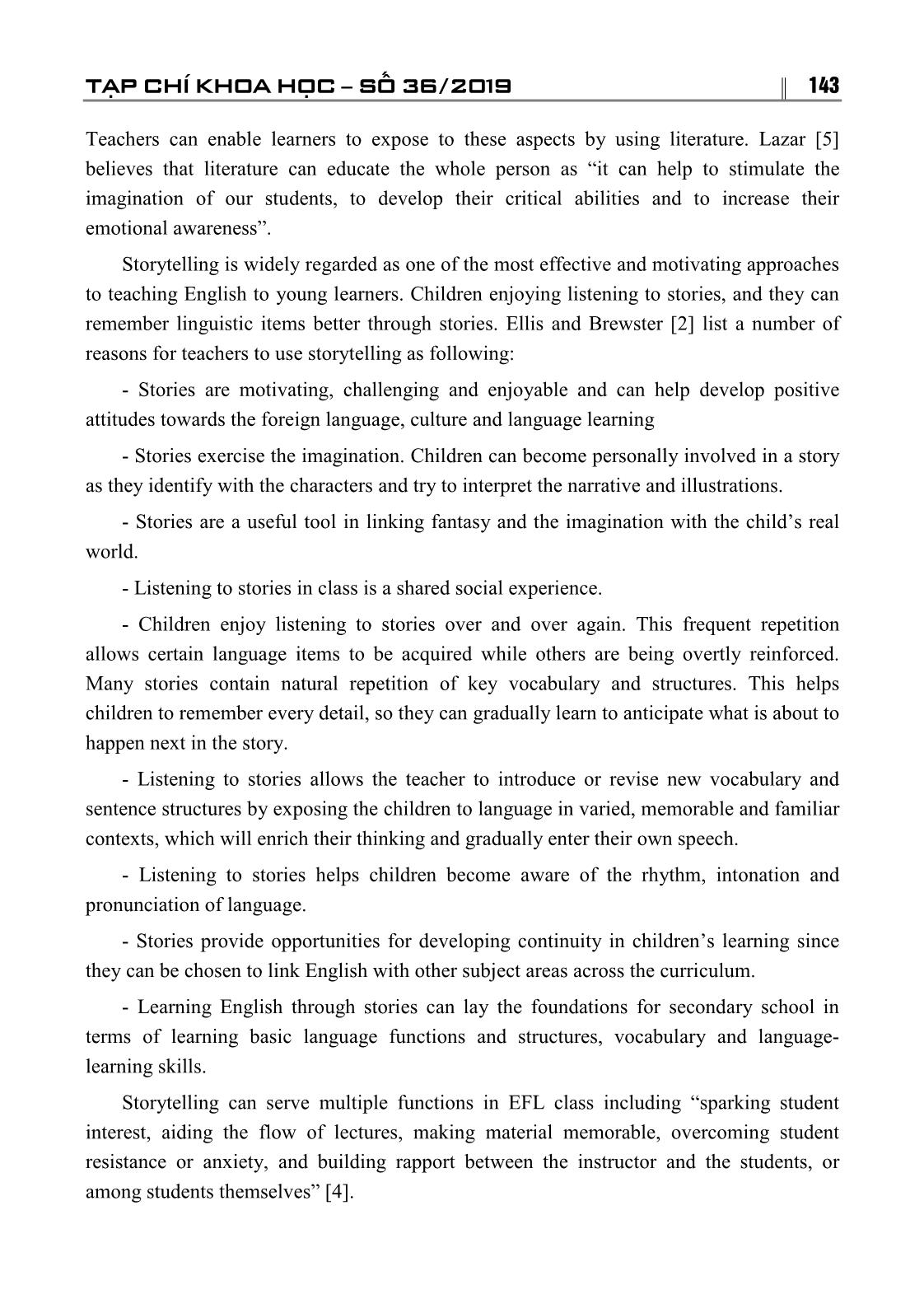
Trang 5
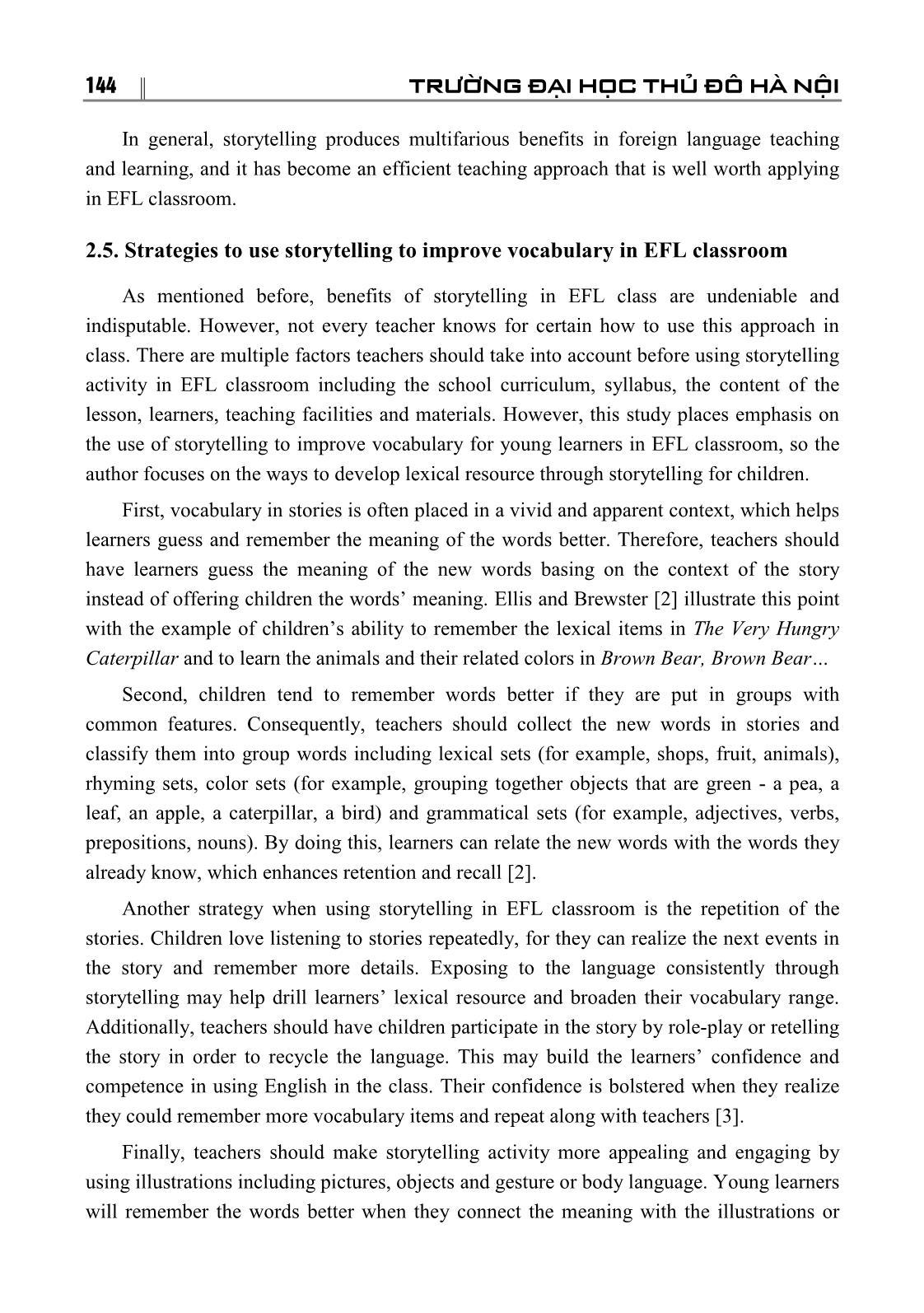
Trang 6
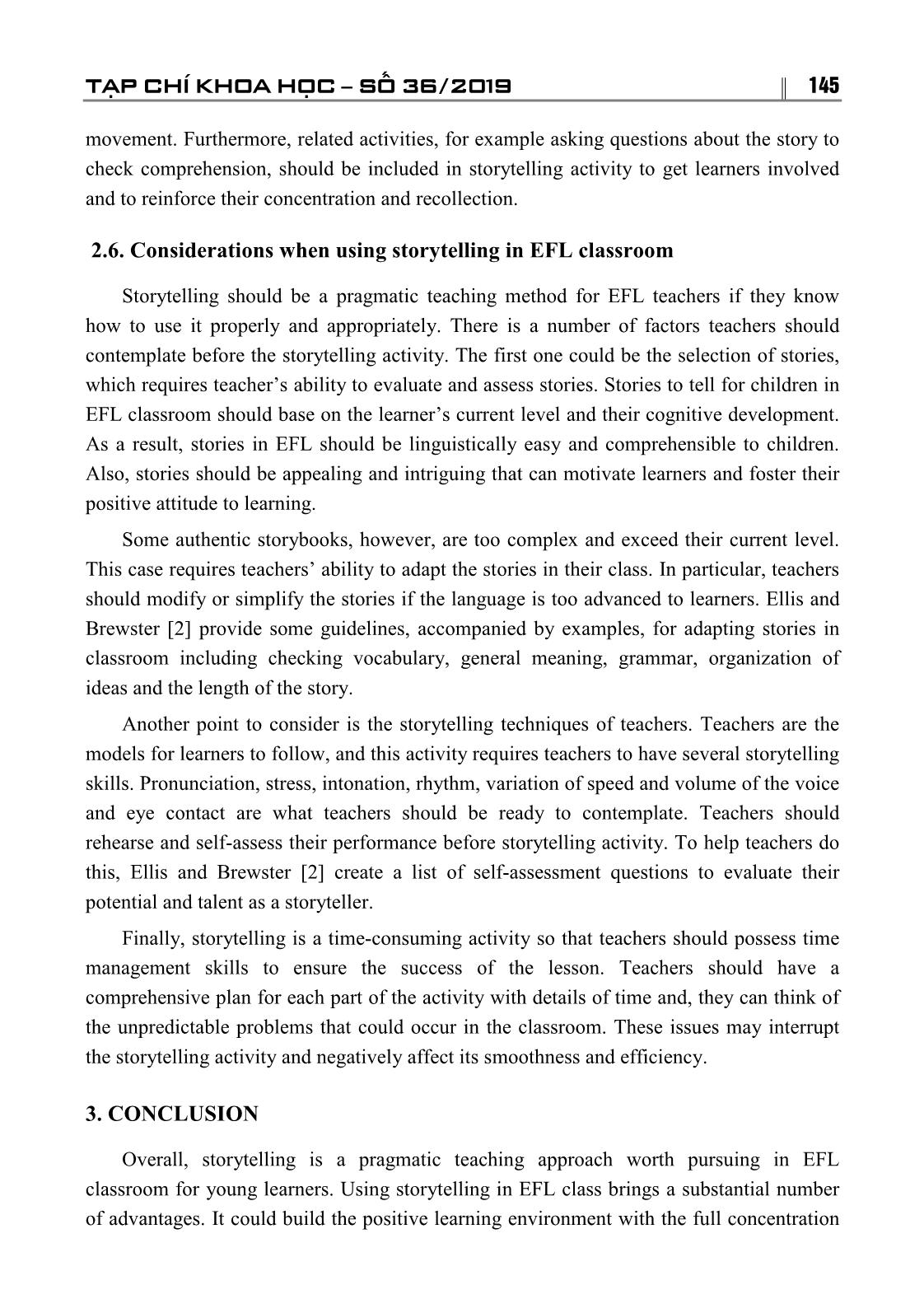
Trang 7
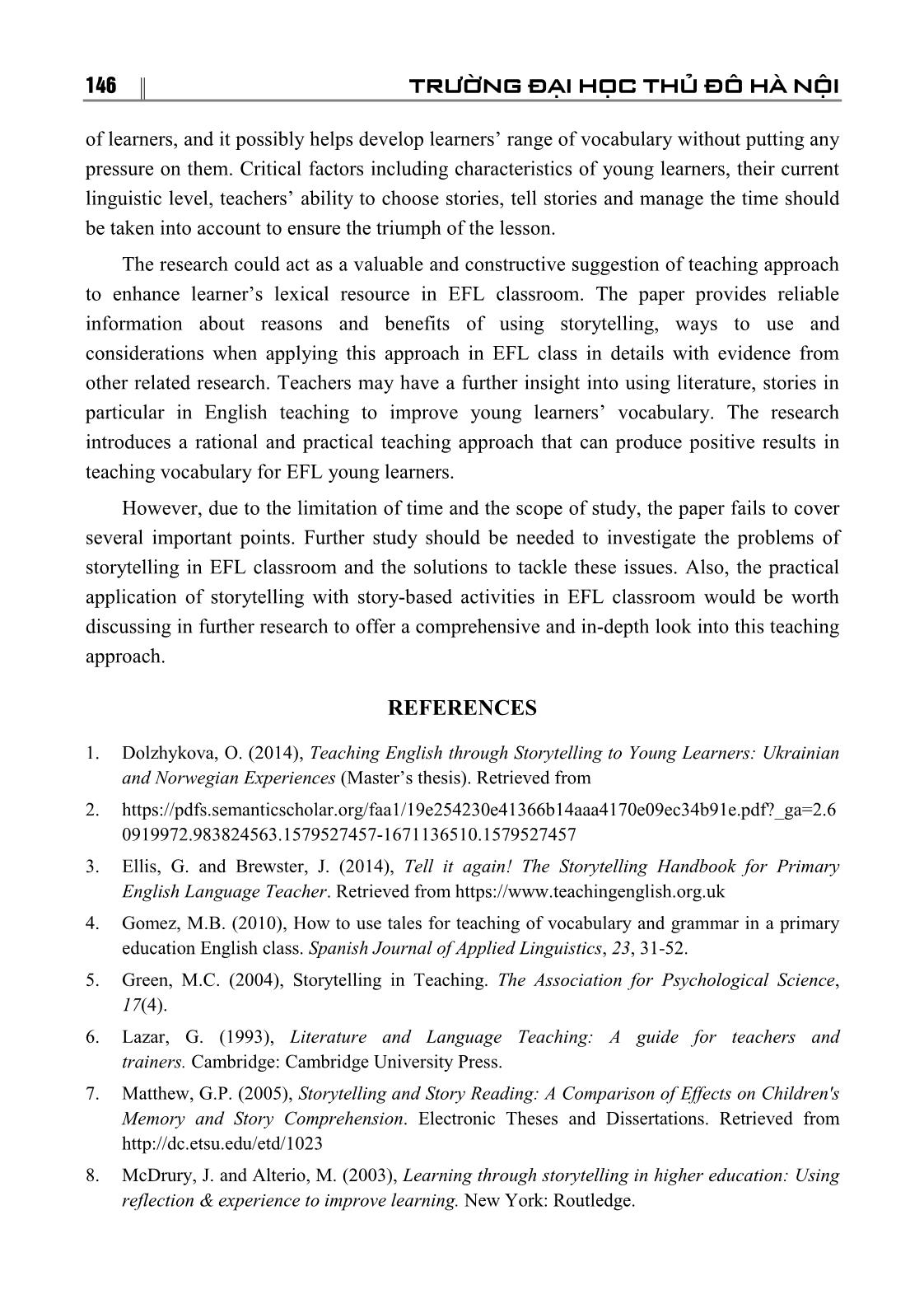
Trang 8
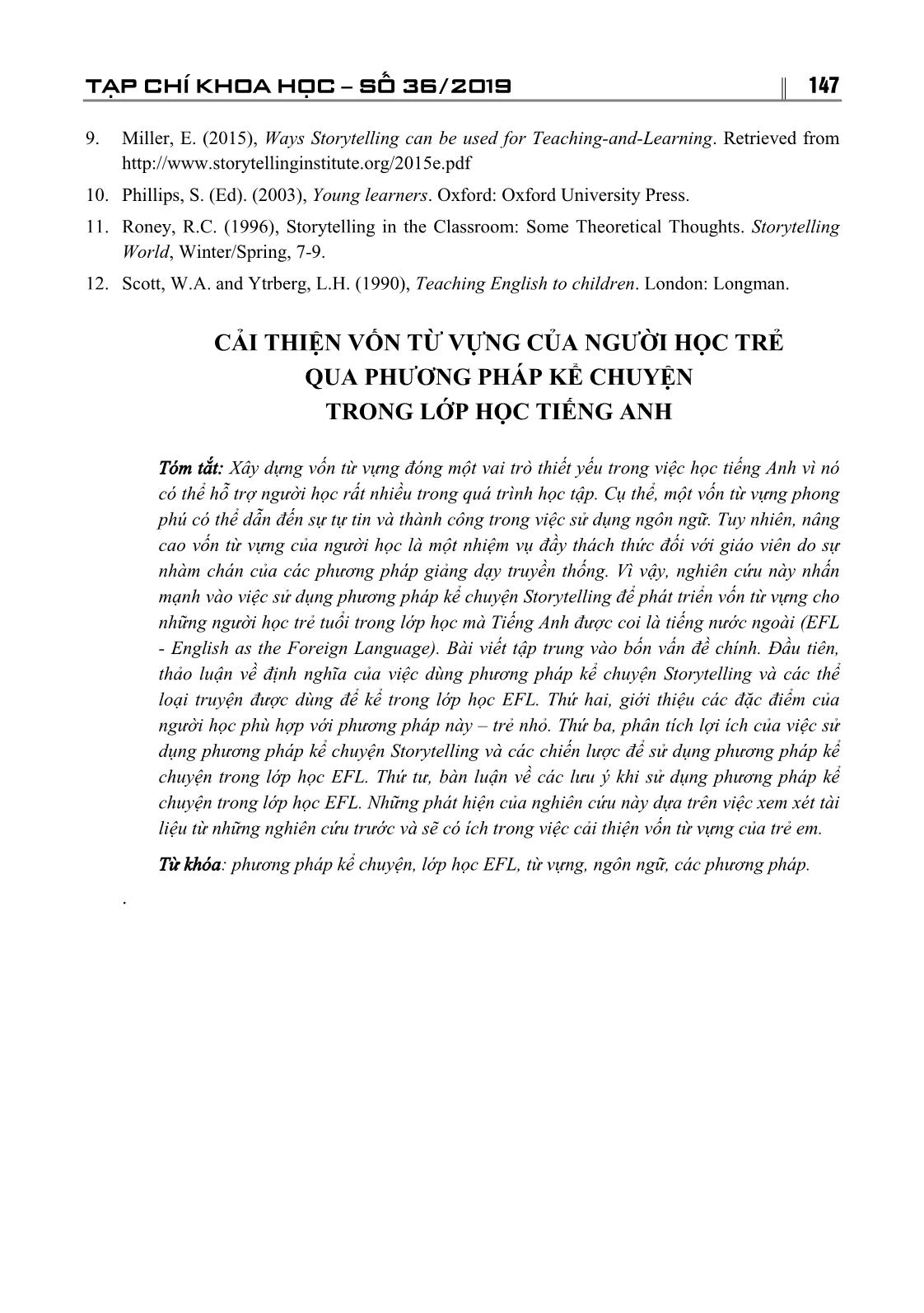
Trang 9
Tóm tắt nội dung tài liệu: Improving vocabulary for young learenrs through storytelling in efl classroom
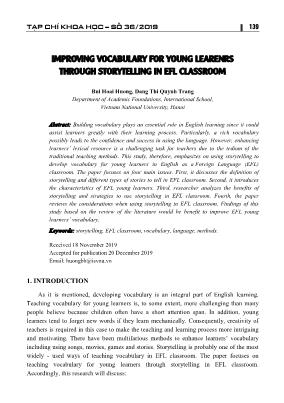
TẠP CHÍ KHOA HỌC SỐ 36/2019 139 IMPROVING VOCABULARY FOR YOUNG LEARENRS THROUGH STORYTELLING IN EFL CLASSROOM Bui Hoai Huong, Dang Thi Quynh Trang Department of Academic Foundations, International School, Vietnam National University, Hanoi Abstract: Building vocabulary plays an essential role in English learning since it could assist learners greatly with their learning process. Particularly, a rich vocabulary possibly leads to the confidence and success in using the language. However, enhancing learners’ lexical resource is a challenging task for teachers due to the tedium of the traditional teaching methods. This study, therefore, emphasizes on using storytelling to develop vocabulary for young learners in English as a Foreign Language (EFL) classroom. The paper focuses on four main issues. First, it discusses the definition of storytelling and different types of stories to tell in EFL classroom. Second, it introduces the characteristics of EFL young learners. Third, researcher analyzes the benefits of storytelling and strategies to use storytelling in EFL classroom. Fourth, the paper reviews the considerations when using storytelling in EFL classroom. Findings of this study based on the review of the literature would be benefit to improve EFL young learners’ vocabulary. Keywords: storytelling, EFL classroom, vocabulary, language, methods. Received 18 November 2019 Accepted for publication 20 December 2019 Email: huongbh@isvnu.vn 1. INTRODUCTION As it is mentioned, developing vocabulary is an integral part of English learning. Teaching vocabulary for young learners is, to some extent, more challenging than many people believe because children often have a short attention span. In addition, young learners tend to forget new words if they learn mechanically. Consequently, creativity of teachers is required in this case to make the teaching and learning process more intriguing and motivating. There have been multifarious methods to enhance learners’ vocabulary including using songs, movies, games and stories. Storytelling is probably one of the most widely - used ways of teaching vocabulary in EFL classroom. The paper focuses on teaching vocabulary for young learners through storytelling in EFL classroom. Accordingly, this research will discuss: 140 TRƯỜNG ĐẠI HỌC THỦ ĐÔ HÀ NỘI (1) The definition of storytelling and types of stories to tell in EFL classroom for young learners (2) The features of young learners (3) The benefits of storytelling in EFL classroom (4) The strategies to apply storytelling to improve vocabulary in EFL classroom (5) The considerations when using storytelling in EFL classroom The purpose of the research is to introduce a new method of improving vocabulary for EFL young learners. Specifically, the researcher aims to yield a detailed insight into using storytelling in EFL classroom, which could be beneficial to EFL teachers and learners. With this innovative teaching method, young learners are likely to learn vocabulary effortlessly and effectively. Findings of this study could be a practical and constructive suggestion for teachers and educators when they desire to find a useful way of enhancing learners’ lexical resource. 2. MAIN CONTENT 2.1. Definitions of Storytelling Storytelling is a method of communication conveying the different events or incidents into words and sounds. There are manifold ways to define the term “storytelling”. According to McDrury and Alterio [7], storytelling is “uniquely a human experience that enables us to convey, through the language of words, aspects of ourselves and others, and the worlds, real or imagined, that we inhabit. Stories enable us to come to know these worlds and our place in them given that we are all, to some degree, constituted by stories”. Other authors propose different definitions of storytelling. Roney [10] defines this term as following: In its most basic form, storytelling is a process where a person (the teller), using vocalization, narrative structure, and mental imagery, communicates with other humans (the audience) who also use mental imagery and, in turn, communicate back to the teller primarily via body language and facial expression. Others may agree with the interpretation of Matthew [6] that storytelling is an “oral presentation of a story from memory by an individual to a person or group”. Likewise, Ellis and Brewster [2] in their book Tell it Again! The Storytelling Handbook for Primary English Language Teachers offer readers another definition of storytelling as “telling a story to people who are willing to listen.” Specifically, a story to be told can be “from a book by reading it aloud”, “without a book by word of mouth in the age-old oral tradition or telling an anecdote or even a joke”. TẠP CHÍ KHOA HỌC SỐ 36/2019 141 Despite a variety of definitions, storytelling can be genera ... e learners have the ability to use the language skills “long before they are aware of them” (p. 2). In addition, eight to ten year old children acquire all the basic elements of the language, and they can use their mother tongue competently with the awareness of grammatical rules of the language. Scott and Ytreberg [11] state that by the end of ten, children can: - understand abstracts - understand symbols (beginning with words) - generalize and systematize This can be seen as the general language development of children. According to Dolzhykova [1], as young learners of a foreign language, children have their own psychological features, which are not the same as those of adult learners. These features including their ways of thinking, attitude and aptitude would have an effect on the way teachers teach them. Knowing it could help teachers prepare and organize their lesson properly and appropriately. However, teachers should also consider the conceptual development of young learners. They are often self-centred and see things from their own perspective, and when they do not know something, they pretend to understand [11]. Knowing and understanding the features of young learners may help teachers to give children the best quality of teaching and plan their teaching activities in the classroom easily and rationally. Also, teachers can get the learners involved in the lesson, and they are probably more engaging and motivating in the activities. 2.4. Benefits of storytelling in EFL classroom Teaching English as a foreign language now cannot be seen simply as introducing the rules of grammar or the morphology, but also helping learners to understand the socio- culture aspects and to have the proficiency in using the language in real communication. TẠP CHÍ KHOA HỌC SỐ 36/2019 143 Teachers can enable learners to expose to these aspects by using literature. Lazar [5] believes that literature can educate the whole person as “it can help to stimulate the imagination of our students, to develop their critical abilities and to increase their emotional awareness”. Storytelling is widely regarded as one of the most effective and motivating approaches to teaching English to young learners. Children enjoying listening to stories, and they can remember linguistic items better through stories. Ellis and Brewster [2] list a number of reasons for teachers to use storytelling as following: - Stories are motivating, challenging and enjoyable and can help develop positive attitudes towards the foreign language, culture and language learning - Stories exercise the imagination. Children can become personally involved in a story as they identify with the characters and try to interpret the narrative and illustrations. - Stories are a useful tool in linking fantasy and the imagination with the child’s real world. - Listening to stories in class is a shared social experience. - Children enjoy listening to stories over and over again. This frequent repetition allows certain language items to be acquired while others are being overtly reinforced. Many stories contain natural repetition of key vocabulary and structures. This helps children to remember every detail, so they can gradually learn to anticipate what is about to happen next in the story. - Listening to stories allows the teacher to introduce or revise new vocabulary and sentence structures by exposing the children to language in varied, memorable and familiar contexts, which will enrich their thinking and gradually enter their own speech. - Listening to stories helps children become aware of the rhythm, intonation and pronunciation of language. - Stories provide opportunities for developing continuity in children’s learning since they can be chosen to link English with other subject areas across the curriculum. - Learning English through stories can lay the foundations for secondary school in terms of learning basic language functions and structures, vocabulary and language- learning skills. Storytelling can serve multiple functions in EFL class including “sparking student interest, aiding the flow of lectures, making material memorable, overcoming student resistance or anxiety, and building rapport between the instructor and the students, or among students themselves” [4]. 144 TRƯỜNG ĐẠI HỌC THỦ ĐÔ HÀ NỘI In general, storytelling produces multifarious benefits in foreign language teaching and learning, and it has become an efficient teaching approach that is well worth applying in EFL classroom. 2.5. Strategies to use storytelling to improve vocabulary in EFL classroom As mentioned before, benefits of storytelling in EFL class are undeniable and indisputable. However, not every teacher knows for certain how to use this approach in class. There are multiple factors teachers should take into account before using storytelling activity in EFL classroom including the school curriculum, syllabus, the content of the lesson, learners, teaching facilities and materials. However, this study places emphasis on the use of storytelling to improve vocabulary for young learners in EFL classroom, so the author focuses on the ways to develop lexical resource through storytelling for children. First, vocabulary in stories is often placed in a vivid and apparent context, which helps learners guess and remember the meaning of the words better. Therefore, teachers should have learners guess the meaning of the new words basing on the context of the story instead of offering children the words’ meaning. Ellis and Brewster [2] illustrate this point with the example of children’s ability to remember the lexical items in The Very Hungry Caterpillar and to learn the animals and their related colors in Brown Bear, Brown Bear Second, children tend to remember words better if they are put in groups with common features. Consequently, teachers should collect the new words in stories and classify them into group words including lexical sets (for example, shops, fruit, animals), rhyming sets, color sets (for example, grouping together objects that are green - a pea, a leaf, an apple, a caterpillar, a bird) and grammatical sets (for example, adjectives, verbs, prepositions, nouns). By doing this, learners can relate the new words with the words they already know, which enhances retention and recall [2]. Another strategy when using storytelling in EFL classroom is the repetition of the stories. Children love listening to stories repeatedly, for they can realize the next events in the story and remember more details. Exposing to the language consistently through storytelling may help drill learners’ lexical resource and broaden their vocabulary range. Additionally, teachers should have children participate in the story by role-play or retelling the story in order to recycle the language. This may build the learners’ confidence and competence in using English in the class. Their confidence is bolstered when they realize they could remember more vocabulary items and repeat along with teachers [3]. Finally, teachers should make storytelling activity more appealing and engaging by using illustrations including pictures, objects and gesture or body language. Young learners will remember the words better when they connect the meaning with the illustrations or TẠP CHÍ KHOA HỌC SỐ 36/2019 145 movement. Furthermore, related activities, for example asking questions about the story to check comprehension, should be included in storytelling activity to get learners involved and to reinforce their concentration and recollection. 2.6. Considerations when using storytelling in EFL classroom Storytelling should be a pragmatic teaching method for EFL teachers if they know how to use it properly and appropriately. There is a number of factors teachers should contemplate before the storytelling activity. The first one could be the selection of stories, which requires teacher’s ability to evaluate and assess stories. Stories to tell for children in EFL classroom should base on the learner’s current level and their cognitive development. As a result, stories in EFL should be linguistically easy and comprehensible to children. Also, stories should be appealing and intriguing that can motivate learners and foster their positive attitude to learning. Some authentic storybooks, however, are too complex and exceed their current level. This case requires teachers’ ability to adapt the stories in their class. In particular, teachers should modify or simplify the stories if the language is too advanced to learners. Ellis and Brewster [2] provide some guidelines, accompanied by examples, for adapting stories in classroom including checking vocabulary, general meaning, grammar, organization of ideas and the length of the story. Another point to consider is the storytelling techniques of teachers. Teachers are the models for learners to follow, and this activity requires teachers to have several storytelling skills. Pronunciation, stress, intonation, rhythm, variation of speed and volume of the voice and eye contact are what teachers should be ready to contemplate. Teachers should rehearse and self-assess their performance before storytelling activity. To help teachers do this, Ellis and Brewster [2] create a list of self-assessment questions to evaluate their potential and talent as a storyteller. Finally, storytelling is a time-consuming activity so that teachers should possess time management skills to ensure the success of the lesson. Teachers should have a comprehensive plan for each part of the activity with details of time and, they can think of the unpredictable problems that could occur in the classroom. These issues may interrupt the storytelling activity and negatively affect its smoothness and efficiency. 3. CONCLUSION Overall, storytelling is a pragmatic teaching approach worth pursuing in EFL classroom for young learners. Using storytelling in EFL class brings a substantial number of advantages. It could build the positive learning environment with the full concentration 146 TRƯỜNG ĐẠI HỌC THỦ ĐÔ HÀ NỘI of learners, and it possibly helps develop learners’ range of vocabulary without putting any pressure on them. Critical factors including characteristics of young learners, their current linguistic level, teachers’ ability to choose stories, tell stories and manage the time should be taken into account to ensure the triumph of the lesson. The research could act as a valuable and constructive suggestion of teaching approach to enhance learner’s lexical resource in EFL classroom. The paper provides reliable information about reasons and benefits of using storytelling, ways to use and considerations when applying this approach in EFL class in details with evidence from other related research. Teachers may have a further insight into using literature, stories in particular in English teaching to improve young learners’ vocabulary. The research introduces a rational and practical teaching approach that can produce positive results in teaching vocabulary for EFL young learners. However, due to the limitation of time and the scope of study, the paper fails to cover several important points. Further study should be needed to investigate the problems of storytelling in EFL classroom and the solutions to tackle these issues. Also, the practical application of storytelling with story-based activities in EFL classroom would be worth discussing in further research to offer a comprehensive and in-depth look into this teaching approach. REFERENCES 1. Dolzhykova, O. (2014), Teaching English through Storytelling to Young Learners: Ukrainian and Norwegian Experiences (Master’s thesis). Retrieved from 2. https://pdfs.semanticscholar.org/faa1/19e254230e41366b14aaa4170e09ec34b91e.pdf?_ga=2.6 0919972.983824563.1579527457-1671136510.1579527457 3. Ellis, G. and Brewster, J. (2014), Tell it again! The Storytelling Handbook for Primary English Language Teacher. Retrieved from https://www.teachingenglish.org.uk 4. Gomez, M.B. (2010), How to use tales for teaching of vocabulary and grammar in a primary education English class. Spanish Journal of Applied Linguistics, 23, 31-52. 5. Green, M.C. (2004), Storytelling in Teaching. The Association for Psychological Science, 17(4). 6. Lazar, G. (1993), Literature and Language Teaching: A guide for teachers and trainers. Cambridge: Cambridge University Press. 7. Matthew, G.P. (2005), Storytelling and Story Reading: A Comparison of Effects on Children's Memory and Story Comprehension. Electronic Theses and Dissertations. Retrieved from 8. McDrury, J. and Alterio, M. (2003), Learning through storytelling in higher education: Using reflection & experience to improve learning. New York: Routledge. TẠP CHÍ KHOA HỌC SỐ 36/2019 147 9. Miller, E. (2015), Ways Storytelling can be used for Teaching-and-Learning. Retrieved from 10. Phillips, S. (Ed). (2003), Young learners. Oxford: Oxford University Press. 11. Roney, R.C. (1996), Storytelling in the Classroom: Some Theoretical Thoughts. Storytelling World, Winter/Spring, 7-9. 12. Scott, W.A. and Ytrberg, L.H. (1990), Teaching English to children. London: Longman. CẢI THIỆN VỐN TỪ VỰNG CỦA NGƯỜI HỌC TRẺ QUA PHƯƠNG PHÁP KỂ CHUYỆN TRONG LỚP HỌC TIẾNG ANH Tóm tắt: Xây dựng vốn từ vựng đóng một vai trò thiết yếu trong việc học tiếng Anh vì nó có thể hỗ trợ người học rất nhiều trong quá trình học tập. Cụ thể, một vốn từ vựng phong phú có thể dẫn đến sự tự tin và thành công trong việc sử dụng ngôn ngữ. Tuy nhiên, nâng cao vốn từ vựng của người học là một nhiệm vụ đầy thách thức đối với giáo viên do sự nhàm chán của các phương pháp giảng dạy truyền thống. Vì vậy, nghiên cứu này nhấn mạnh vào việc sử dụng phương pháp kể chuyện Storytelling để phát triển vốn từ vựng cho những người học trẻ tuổi trong lớp học mà Tiếng Anh được coi là tiếng nước ngoài (EFL - English as the Foreign Language). Bài viết tập trung vào bốn vấn đề chính. Đầu tiên, thảo luận về định nghĩa của việc dùng phương pháp kể chuyện Storytelling và các thể loại truyện được dùng để kể trong lớp học EFL. Thứ hai, giới thiệu các đặc điểm của người học phù hợp với phương pháp này – trẻ nhỏ. Thứ ba, phân tích lợi ích của việc sử dụng phương pháp kể chuyện Storytelling và các chiến lược để sử dụng phương pháp kể chuyện trong lớp học EFL. Thứ tư, bàn luận về các lưu ý khi sử dụng phương pháp kể chuyện trong lớp học EFL. Những phát hiện của nghiên cứu này dựa trên việc xem xét tài liệu từ những nghiên cứu trước và sẽ có ích trong việc cải thiện vốn từ vựng của trẻ em. Từ khóa: phương pháp kể chuyện, lớp học EFL, từ vựng, ngôn ngữ, các phương pháp. .
File đính kèm:
 improving_vocabulary_for_young_learenrs_through_storytelling.pdf
improving_vocabulary_for_young_learenrs_through_storytelling.pdf

